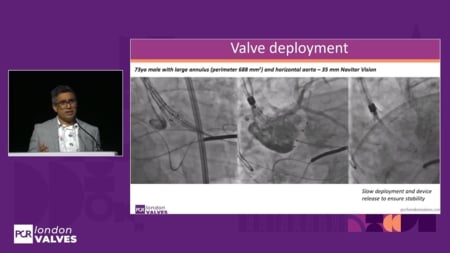Frequency and safety of bioprosthetic valve fracture in patients undergoing valve in valve TAVR for failed surgical valves using the SAPIEN 3/Ultra Valves: Insights from real-world data
Reported from TCT 2022
Michele Pighi provides his take on this trial which aimed to compare the safety and efficacy of VIV-TAVI with or without bioprosthetic valve fracture. It was presented by Santiago Garcia during the TCT Congress 2022.
Why this study? – the rationale/objective
From the early 2000’ trends showed a progressive increase in the use of bioprosthetic valves in open heart surgery for the treatment of symptomatic aortic stenosis (AS). This shift in surgical practice, together with the shorter durability of biological valves compared to mechanical ones, led to a progressive increase in patients presenting symptomatic AS in degenerate prostheses. Valve-in-valve (VIV) transcatheter aortic valve replacement (TAVR) has been established as a safe and effective means of treating failed surgical bioprosthetic valves in patients at high risk for complications related to reoperation.
Patients who undergo VIV TAVR are at risk of patient–prosthesis mismatch, as the transcatheter heart valve (THV) is implanted within the ring of the existing prosthesis, limiting full expansion and reducing the maximum achievable effective orifice area of the THV.
Importantly, patient–prosthesis mismatch and high residual transvalvular gradients are associated with reduced survival following VIV TAVR. Bioprosthetic valve fracture (BVF) with high-pressure balloon inflation to dilate the bioprosthetic valve has emerged as a strategy permitting further expansion of the THV, improving hemodynamic results in such patients. Nevertheless, up to date, due to the paucity of the data, mainly belonging to small observational studies and lacking comparison with control group indications, the definition of success and optimal timing are still aspects warranting further investigation.
The objective of the study was to compare the safety and efficacy of VIV-TAVI with or without BVF.
How was it executed? - the methodology
The present study enrolled an overall population of 2975 patients who underwent VIV-TAVI with SAPIEN 3 or SAPIEN 3 Ultra (S3/U) between December 2020 and March 2022 and were included in the TVT Registry. The study focused on:
- Safety outcomes (all-cause in-hospital mortality) - The primary comparison of the study was attempted- [n=619 (21%)] versus non-attempted BVF [n=2356 (79%)] groups. The secondary comparison focused on the timing of BVF with pre-implant [n=141 (23%)] versus post-implant BVF [n=466 (75%)].
- Hemodynamic outcomes (echocardiographic aortic valve area and mean gradient), including only patients with a known true internal diameter of the surgical valve (population of interest n= 1085 pts) - The primary comparison of the study was attempted- [n= 250 (23%)] versus non-attempted BVF [n=835 (77%)] groups. The secondary comparison focused on the timing of BVF with pre-implant [n=55 (22%)] versus post-implant BVF [n=189 (76%)].
What is the main result?
In terms of safety outcomes:
- patients in the BVF group showed an increased risk of all-cause mortality (OR 2.51, 95% CI: 1.30 – 4.84, p<0.01), cardiac death (OR 2.47, 95% CI: 1.13 – 5.39, p=0.02), all-cause mortality/stroke (OR 1.94, 95% CI: 1.13 – 3.33, p=0.02) and life-threatening bleeding (OR 2.55, 95% CI: 1.44 – 4.50, p<0.01).
- with regard to the pre-implant vs. post-implant BVF, the former strategy was found to be associated with a significantly increased risk of all-cause mortality (OR 2.90, 95% CI: 1.21 – 6.94, p=0.02) and cardiac death (OR 3.49, 95% CI: 1.25 – 9.37, p=0.02). Of note, no events of stroke were detected in the pre-implant cohort.
In terms of echocardiographic outcomes:
- Patients in the BVF group showed a significant increased aortic valve area (AVA) at discharge (1.6 vs. 1.4 cm^2, p<0.01) compared to the no-BVF counterpart (baseline AVA=0.8 cm^2, for both groups). At the same time, the BVF group showed a significant lower mean valve gradient (MVG) compared to the no-BVF patients both at discharge (16.3 vs. 19.2 mmHg, p<0.01) and 30-day follow-up (18.2 vs. 22.0 mmHg, p<0.01).
- With regard to the comparison between pre-implant vs. no-BVF, the former strategy showed significantly lower gradients at discharge (15.6 vs. 18.3 mmHg, p=0.01) but not at the 30-day follow-up. While when performed post-implant, BVF showed an advantage in terms of MVG reduction both at discharge (16.4 vs. 19.4 mmHg, p<0.01) and at the 30-day follow-up (22.6 vs. 18.3 mmHg, p<0.01).
The authors concluded that the adjunctive treatment as such BVF, in the context of Viv-TAVI with S3/Ultra platforms, was associated with an early hazard of in-hospital mortality, with the risk of mortality being higher when BVF was performed prior to TAVI. Albeit such increased risks, the BVF strategy showed only modest advantages in terms of AVA and echocardiographic gradients.
In summary
- This is a large contemporary report on the use of bioprosthetic valve fracture in the context of Viv-TAVI using S3/Ultra prostheses.
- In light of the increased risk of all-cause mortality and cardiac death and the modest hemodynamic benefits in the short-term shown in the study, the long-term risk/benefit of BVF requires further characterization to identify possible subgroups which may benefit from such a strategy.
- The impact of BVF timing on valve durability and leaflet integrity is a key aspect that warrants further investigation
- With the progressive increase in the number of patients requiring Viv-TAVI in the context of degenerated surgical bioprostheses, better standardization of indications, techniques, and follow-up management is warranted.
References
- Timing of Bioprosthetic valve fracture in transcatheter valve-in-valve intervention: impact on valve durability and leaflet integrity. EuroIntervention, Meier et al. DOI: 10.4244/EIJ-D-22-00644






No comments yet!